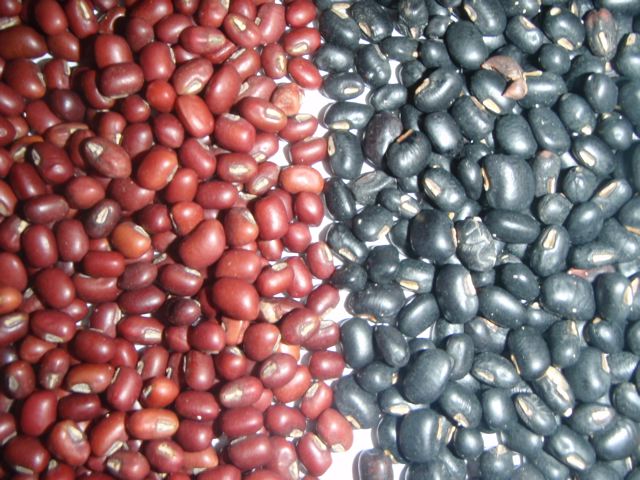Weeds
Grasses
Sedges
Broadleaf
Diseases
Fungal
Bacterial
Viral
Agro-ecology
Cowpea is important in multiple cropping systems which involve monocropping, relay cropping, and mixed intercropping.
In Asia, cowpea is grown as an intercrop with cereals, cotton or sugarcane, and relay-cropped in standing rice. In rain-fed Southeast Asia, cowpea is usually grown after rice when soil moisture is limited. Early-maturing cultivars are sown in late April to early May, with the harvest at the end of June or early July, before rice is transplanted. In Africa, cowpea is grown as an intercrop with millet, sorghum, or corn (CABI, 2000).
A study entitled, “
Improving cowpea-cereals-based cropping systems in the dry savannas of West Africa”, was conducted to evaluate cereal-cowpea intercropping row arrangements and the effect of 100 kg NPK (15-15-15) /ha basal and 20 kg N/ha top-dressed on cereals. The results showed that a sole crop of improved cowpea variety was the most profitable, followed a by 2-row cereal/4-row cowpea intercropping system. At a farmers’ level evaluation, 2-row sorghum/4-row of cowpea gave 100-300% gross economic superiority, with the above
fertilizer dosage. Results further indicated, that small landholder farmers in these areas preferred the 2-row sorghum/4-row of cowpea intercropping system because it provided them with sorghum and cowpea both for home consumption and cash income (Fatokum; et. al., 2000: pp. 278-288).
The practice of cereal-cowpea intercropping and crop rotation coupled with effective soil fertility management can increase yields of cereals succeeding cowpea. Cowpea can fix up to 88 kg N/ha (Fatokum; et.al. 2000: pp. 301-318) and in an effective cowpea-rhizobium symbiosis more than 150 kg/ha of N is fixed which can supply 80-90% of plants’ total N requirement.
Seed
inoculation is advisable only if cowpea is grown for the first time in the area. In
most soils, native Rhizobium strains can nodulate the plants. In general, fertilizer application is not employed. With proper crop management, application compost or farm manure can increase the yield of cowpea.
Stored seeds must have a moisture content of 14% or less. Seed treatment with palm, groundnut, or coconut oil protects seeds during storage (CABI, 2000; CABI, 2004). Stored seeds are extremely susceptible to insect infestation.
Further information
The International Institute of Tropical Agriculture (IITA), the International Development Research Center (IDRC), and Cornell University are facilitating a cover crop information exchange within and between countries in Africa and worldwide through the Internet. The project “PEDUNet: Electronic Networking for Cowpea IPM” promotes the development and exchange of training materials that can be downloaded from the Internet and be used on farms across the region. It is working to support
the cowpea IPM research and extending training programs in nine countries across West, Central, and Southern Africa. National program scientists have clustered their researches into appropriate themes and identified associated technical needs, using PEDUNet http://www.iita.org/info/ar98/24-26.htm) as the electronic discussion forum to underpin their initiatives (ITTA, 1998: pp. 24-26).
A study (conducted by ITTA in Nigeria representing Sudan savanna) on the use of the beneficial effects of soap spray and neem leaf spray to control cowpea insect pests showed that the mean grain yield of the improved cowpea variety IT90K-277-2 was 361 kg/ha without insecticide; 516 kg/ha with soap spray; and 509 kg/ha with neem leaf extract spray. However, these yields are much less when compared to plots sprayed 2-3 times with synthetic pesticides (ITTA, 2002: 23).
External links
References
- CABI. (2000): Crop protection compendium. Global module, 2nd edition. CABI Publishing, Wallingford, UK.
- CABI. (2004): Crop protection compendium. 2004 Edition. CAB International Publishing. Wallingford, UK.
- Fatokum, C.; Tarawali, C.; Singh, B.; Kormata, P.; Tamo, M., editors. (2000): Challenges and opportunities for enhancing sustainable cowpea production. Proceedings of the World Cowpea Conference III held in International Institute of Tropical Agriculture (IITA). Ibadan, Nigeria.
- ITTA (2002): Improving and intensifying cereal-legume systems in the moist and dry savannas of the west and central Africa. Annual Report 2002. International Institute. Ibadan, Nigeria. pp. 23
- ITTA. (1998): CIEPCA The cover crops information and seed exchange center. Annual Report 1998. International Institute. Ibadan, Nigeria. pp. 24-26

